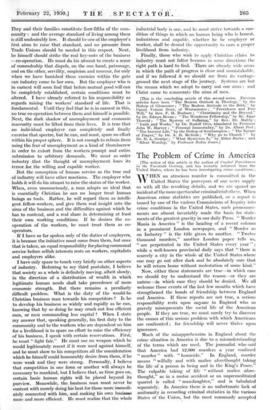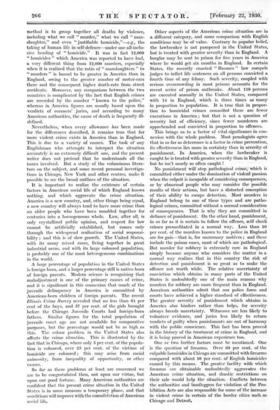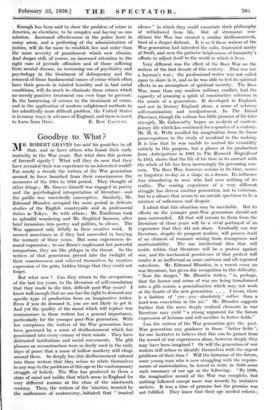The Problem of Crime in America
[The writer of this article is the author of Capital Punishment in the Twentieth Century, and has recently returned from the United States, where he has been investigating crime conditions.]
-vvHEN an atrocious murder is committed in the United States the purveyors- of our news supply us with all the revolting details, and we arc spared. no incident of the more spectacular criminal trials there. When American crime statistics are published, or a report is issued by one of the various Commissions of Inquiry into crime conditions in the United States, such pronounce- ments are almost invariably made the basis for state- ments of the greatest gravity in our daily Press. " Murder Mania in America " is the heading of a recent column in a prominent London newspaper, and " Murder as an Industry " is the title given to another. " Twelve thousand .murders," another London paper tells us, " are perpetrated in the United States every year " ; while a well-known provincial daily says that " there is scarcely a city in the whole of the United States where one may go out after dark and be absolutely sure that he will return home without molestation of some kind."
Now, either these statements are true—in which case we should try to understand the reason—or they are untrue—in which case they should be denied. We all welcome those events of the last few months which have strengthened the bonds of friendship between England and America. If these reports are not true, a serious responsibility rests upon anyone in England who so gravely misrepresents the social life of the American people. If they are true, we must surely try to discover the causes of this serious problem with which Americans are confronted ; for friendship will never thrive upon ignorance.
Much of the misapprehension in England about the crime situation in America is due to a misunderstanding of the terms which are used. The journalist who said that America had 12,000 murders a year confused " murder " with " homicide." In England, murder means " wilfully and with malice aforethought taking the life of a person in being and in the King's Peace." The culpable taking of life • " without malice afore- thought," as in a motor accident or an unpremeditated quarrel is called " manslaughter," and is tabulated separately. In America there is an unfortunate lack of _uniformity in. recording criminal statistics in the various States of the -Union, but the most commonly accepted method is to group together all deaths by violence, including what we call " murder," what we call " man- slaughter," and even " justifiable homicide,"—e.g., the taking of human life in self-defence—under one all-inclu- sive heading of " homicide." It was in fact 12,000 homicides " which America was reported to have had, a very different thing from 12,000 murders, especially when it is realized that the ratio of " manslaughters " to " murders " is bound to be greater in America than in England, owing to the greater number of motor-cars there and the consequent higher death-rate from street accidents. Moreover, any comparison between the two countries is complicated by the fact that English crimes are recorded by the number " known to the police," whereas in America figures are usually based upon the verdicts of coroners' juries, and according to many American authorities, the cause of death is frequently ill- defined.
Nevertheless, when every allowance has been made for the differences described, it remains true that far more violent crime exists in America than in England. This is due to a variety of causes. The task of any Englishman who attempts to interpret the situation accurately is an extremely difficult one, and the present writer does not pretend that he understands all the issues involved. But a study of the voluminous litera- ture on the subject, and some recent personal investiga- tions in Chicago, New York and other centres, make it possible to see the broad outlines of the situation.
It is important to realize the existence of certain factors in American social life of which England knows nothing, and which aggravate the crime situation. America is a new country, and, other things being equal, a new country will always tend to have more crime than an older people who have been moulded together for centuries into a homogeneous whole. Law, after all, is only crystallized public opinion, and respect for law cannot be artificially established, but comes only through the widespread realization of social responsi- bility ; and this is of slow growth. The United States, with its many mixed races, living together in great industrial areas, and with its large coloured population, is probably one of the most heterogeneous combinations in the world.
A large percentage of population in the United States is foreign born, and a larger percentage still is native born of foreign parents. Modern • science is recognizing that maladjustment is one of the primary causes of crime, and it is significant in this connexion that much of the juvenile delinquency in America is committed by American-born children of foreign parents. The recent Illinois Crime Surrey revealed that no less than 64 per cent of the boys, and 57 per cent. of the girls brought before the Chicago Juvenile Courts had foreign-born fathers. Similar figures for the total population of juvenile court age are not available for comparative purposes, but the percentage would not be as high as this. The colour problem in the United States also affects the crime situation. This is illustrated by the fact that in Chicago, where only 5 per cent. of the popula- tion is coloured, over 25 per cent. of the victims of homicide are coloured ; this may arise from racial animosity, from inequality of opportunity, or other causes.
So far as these problems at least are concerned we are to be congratulated then, not upon our virtue, but upon our good fortune. Many American authorities are confident that the present crime situation in the United States is in some measure a temporary phase, and that conditions will improve with the consolidation of AmeriCan social life. Other aspects of the American crime situation are in a different category, and some comparison with English conditions may be of value. Contrary to popular belief, the lawbreaker is not pampered in the United 'States, but is treated -with greater severity. than in England. A burglar may, be sent to prison for five years in America where he would get six months in England. In certain States, the recently enacted " Baumes " law compels judges to inflict life sentences on all persons convicted a fourth time of any felony. Such severity, coupled with serious overcrowding in most prisons accounts for the recent series of prison outbreaks. About 110 persons are executed annually in the United States, compared with 14 in England, which is. three times as many in proportion to population. It is true that in propor- tion to homicidal crimes committed there are fewer executions in America ; but that is not a question of severity but of efficiency, since fewer murderers are apprehended and convicted in proportion to offences.
This brings us to a factor of vital significance in con- nexion with the whole problem. Most penologists agree that in so far as deterrence is a factor in crime prevention, its effectiveness lies more in certainty than in severity of punishment. In America, when the lawbreaker is caught he is treated with greater severity than in England, but he isn't nearly so often caught !
No punishment will stop pathological crime,`="'Which is committed either under the domination of violerit'passion when the culprit is incapable of considering consequences; or by abnormal people who may consider the possible results of their actions, but have a distorted conception of their ability to escape detection. Most murders in England belong to one of these types and are patho- logical crimes, committed without a normal consideration of consequences. That is why they are committed in defiance of punishment. On the other hand, punishment, in so far as it is certain to follow the offence, will check crimes premeditated in a normal way. Less than 10 per cent. of the murders known to the police in England are for gain—that is, for mercenary motives ; and these include the poison cases, most of which are pathological.
But murder for robbery is extremely rare in England simply because anyone who considers the matter in a normal way realizes that in this country the risk of detection and punishment is so great as to make the offence not worth while. The relative uncertainty of conviction which obtains in many parts of the United States 'is undoubtedly one of the main reasons why murders for robbery are more frequent than in England.
American authorities admit that our police force and courts have achieved a higher standard of effectiveness. The greater severity of punishment which obtains in America also hinders rather than helps, for severity always breeds uncertainty. Witnesses are less likely to volunteer evidence, and juries less likely to return verdicts of guilty when punishments are out of harmony with the public conscience. This fact has been proved in the history of the treatment of crime in England, and it is being proved in American experience too.
One or two further factors must be mentioned. One is the question of firearms. Over 60 per cent. of the culpable homicides in Chicago are committed with firearms compared with about 10 per dent. of English homicides caused by this means. The greater facility with: which firearms are obtainable undoubtedly aggravates the American crime situation, and drastic restrictions on their sale would help the situation. Conflicts between the' authorities and bootleggers for violation of .the Pro- hibition Acts are also responsible for some of the increase in violent crime in certain of the border cities such as Chicago and Detroit. Enough has been said to show the problem of crime in America, as elsewhere, to be complex and having no one solution. Increased effectiveness in the police force in many, areas, and a perfecting of the administration of justice, will do far more to establish law and order than the mere severity of punishment which now obtains. And deeper still, of course, an increased attention to the right care of juvenile offenders and of those suffering from mental disease, an increasing use of psychiatry and psychology in the treatment of delinquency and the removal of those fundamental causes of crime which often have their genesis in tainted heredity and in bad social conditions, will do much to eliminate those crimes which no merely punitive treatment can ever hope to prevent. In the harnessing of science to the treatment of crime, and in the application of modern enlightened methods to her admittedly more difficult problem, the United States is in many ways in advance of England, and there is much












































 Previous page
Previous page